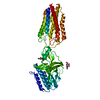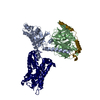+Search query
-Structure paper
| Title | Conformational transitions and activation of the adhesion receptor CD97. |
|---|---|
| Journal, issue, pages | Mol Cell, Vol. 84, Issue 3, Page 570-583.e7, Year 2024 |
| Publish date | Feb 1, 2024 |
 Authors Authors | Chunyou Mao / Ru-Jia Zhao / Ying-Jun Dong / Mingxin Gao / Li-Nan Chen / Chao Zhang / Peng Xiao / Jia Guo / Jiao Qin / Dan-Dan Shen / Su-Yu Ji / Shao-Kun Zang / Huibing Zhang / Wei-Wei Wang / Qingya Shen / Jin-Peng Sun / Yan Zhang /  |
| PubMed Abstract | Adhesion G protein-coupled receptors (aGPCRs) are evolutionarily ancient receptors involved in a variety of physiological and pathophysiological processes. Modulators of aGPCR, particularly ...Adhesion G protein-coupled receptors (aGPCRs) are evolutionarily ancient receptors involved in a variety of physiological and pathophysiological processes. Modulators of aGPCR, particularly antagonists, hold therapeutic promise for diseases like cancer and immune and neurological disorders. Hindered by the inactive state structural information, our understanding of antagonist development and aGPCR activation faces challenges. Here, we report the cryo-electron microscopy structures of human CD97, a prototypical aGPCR that plays crucial roles in immune system, in its inactive apo and G13-bound fully active states. Compared with other family GPCRs, CD97 adopts a compact inactive conformation with a constrained ligand pocket. Activation induces significant conformational changes for both extracellular and intracellular sides, creating larger cavities for Stachel sequence binding and G13 engagement. Integrated with functional and metadynamics analyses, our study provides significant mechanistic insights into the activation and signaling of aGPCRs, paving the way for future drug discovery efforts. |
 External links External links |  Mol Cell / Mol Cell /  PubMed:38215752 PubMed:38215752 |
| Methods | EM (single particle) |
| Resolution | 2.33 - 4.32 Å |
| Structure data | EMDB-35514, PDB-8ikj: EMDB-35516, PDB-8ikl:  EMDB-38938: Cryo-EM structure of the inactive CD97  EMDB-38939: Cryo-EM structure of the inactive CD97  EMDB-38980: Cryo-EM structure of the inactive CD97 |
| Chemicals |  ChemComp-NAG: |
| Source |
|
 Keywords Keywords |  MEMBRANE PROTEIN / adhension GPCR / MEMBRANE PROTEIN / adhension GPCR /  CD97 / CD97 /  inactive / G13 / inactive / G13 /  complex complex |
 Movie
Movie Controller
Controller Structure viewers
Structure viewers About Yorodumi Papers
About Yorodumi Papers









